Anxiety is something that affects all of us from time to time. We all go through it. Even though anxiety affects both genders, the manifestation of anxiety in women is different from how it manifests in men. Increase in studies focussing on anxiety has now forced researchers to start understanding anxiety symptoms in women due to the wide variety of responses that differ for anxiety in men and women.
In this article, I will show you how anxiety shows different symptoms in case of females compared to men. There is no one-size-fits-all approach when it comes to anxiety. Here we will look into the different symptoms of anxiety as they affect women. You have to understand, that anxiety is not a transient condition. It won’t go away on its own. It is a complex interplay of different environmental and biological elements that can have a massive impact on the well- being and health of women. The aim of this blog post is to shed some light on the benefits of recognizing, understanding. acknowledging and finally, addressing symptoms of anxiety in the fair gender.
Table of Contents
Anxiety symptoms in women: want to know more?
If you wish to know more about anxiety, depression, mental health disorders or if you wish to lead a more positive and productive life, subscribe to Guilt Free Mind. The subscription option is present in the sidebar. If you like watching videos, subscribe to the YouTube channel of Guilt Free Mind. Remember to ring the notification bell so YouTube can notify you the moment a new mental health video releases from the channel.
This blog post is not just for you. It is for communities, families and every individual, whether they suffer from anxiety or not. Remember, knowledge is power. The more knowledge you have, the better you can protect yourself. So share this blog post with your spouse, friends, family etc so more people understand anxiety symptoms in women and how to deal with the same. Let’s begin this blog post with a discussion of the types of anxiety disorders:
The types of anxiety disorders
Anniety disorders comprise of many mental health conditions that are usually characterised by worry, fear or apprehension. Even though anxiety does not check gender before affecting, women show symptoms that are different from men. This is primarily due to the influence of the various sociocultural and biological factors. Here are details of some of the primary anxiety disorders:
Generalized Anxiety disorder (GAD)
Generalized anxiety disorder (GAD) is characterized by excessive and persistant worry about even the small things of ones day to-day life. These worries often do not have a logical foundation.
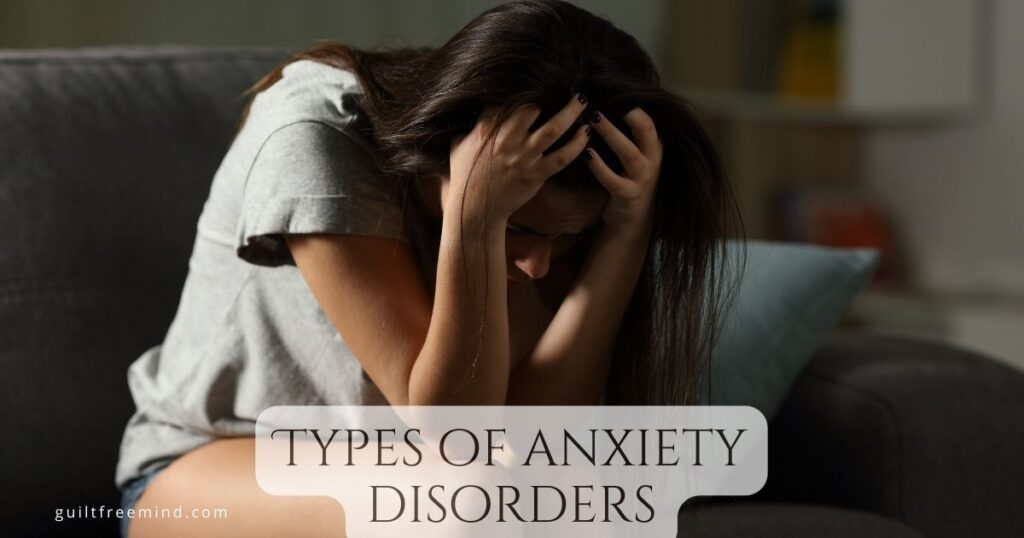
Anxiety symptoms in women
Those who face Generalized Anxiety Disorder often experience heightened worry regarding their family, relationships, friendships and other social expectations. Most often GAD occurs as a result of wearing many hats and juggling many roles in one’s even day life.
Panic disorders
Panic disorders are characterised by the occurrence of unexpected and recurrent panic attacks. These are often accompanied by intense psychological and physical symptoms. Most often, the person may not even be aware of what brought on the panic. attack in the first place.
Anxiety symptoms in women
Studies have shown that women have a higher chance of developing panic disorder compared to men. The most common reasons behind this are fluctuations in hormone levels, menopause, pregnancy or any other form of hormone imbalance. These can alter the severity and frequency of panic attacks in women.
Social anxiety disorder
This form of anxiety disorder is characterized by an exceptionally intense fear of social situations. This mostly arises from past events of humiliation, negative judgement. embarrassing moments or fear of the same.
Symptoms in women
The occurance of social anxiety disorders is higher in women due to the societal expectations and gender roles that have been assigned to women. Women feel that it they do not adhere to specific rules or codes of conduct in the society , they will be mocked. They face heightened pressure regarding social interaction, appearance, and performance.
Specific phobias
Specific phobias are having an intense and irrational fear of a specific place, situation, object or activity.
Symptoms in women
We live in a society where men are expected to be brave and unafraid. On the other hand, women are expected to be afraid and timid. In many cases kids learn the phobias from their mothers and as and when they grow, the phobias grow along with them. By the time they reach adulthood , their fears have solidified into phobias.
Alternatively gender specific experiences can also contribute to the development of specific phobias in women. These could be traumatic events like abuse or sexual assault to procedures like childbirth, medical procedures or social situations.
The reason I chose to first discuss the different types of anxiety disorder is because understanding these is crucial for the development of support systems and effective prevention methods in women. When these specific aspects are taken into consideration, it becomes easier to address the unique challenges that females face and develop an environment that promotes the well-being of the person.
Factors contributing to anxiety symptoms in women
Biological factors that contribute to anxiety symptoms in women
As I mentioned before, biological factions have a huge role in boosting the symptoms of anxiety in women. If you want to understand why women show different symptoms than men in case of anxiety disorders, then understanding the role of biological factors is crucial. In this article, I will primarily focus on two aspects of biological factors that influence anxiety symptoms in women.
Hormonal influences on anxiety symptoms in women
Hormonal changes and menstrual cycle
Women constantly face changing hormone levels due to their menstrual cycle. As one hormone production reduces, the other increases. The pre-menstrual phase is characterized by fluctuations in the levels of progesterone and estrogen. These can cause mood swings and high levels of anxiety in some women.
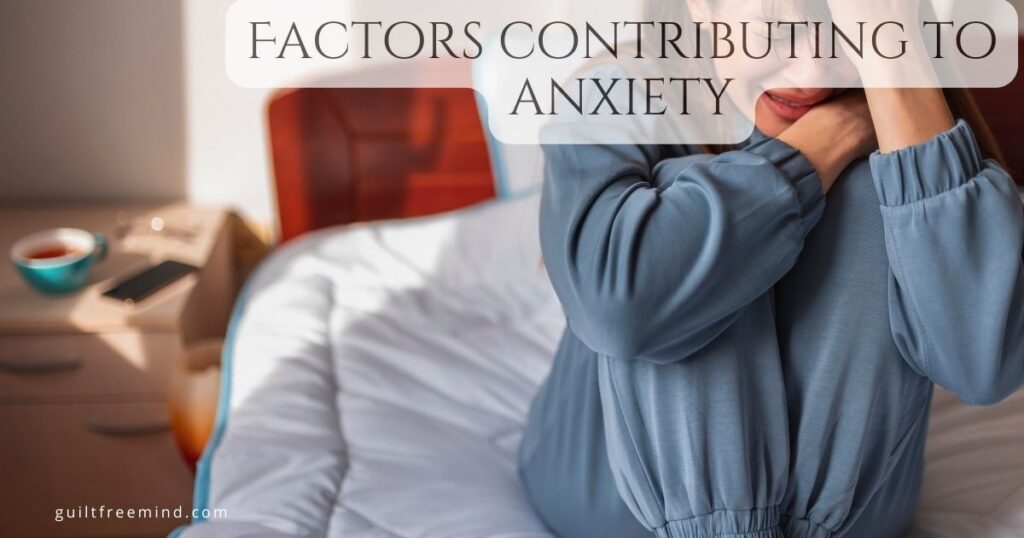
Those who suffer from premenstrual dysphoric disorder (PMS) also have high levels of hormone fluctuation. This can also cause high anxiety in the days that just precede menstruation.
Studies have shown that women who suffer from Poly Cystic Ovarian Syndrome (PCOS) also show high levels of social anxiety, panic attacks and generalized anxiety disorder symptoms. This is due to the physical manifestation of PCOS. Those who struggle with infertility as a result of PCOS go through anticipatory anxiety related to the worry about if they will ever be able to have kids.
Pregnancy and post-partum
During pregnancy there is a constant hormonal shift in the female’s body. The same occurs during postpartum as well. These high fluctuations in a female’s hormone levels can have a massively negative impact on their mental health. Postpartum anxiety is most often characterized by symptoms of high fear and worry about the child care process of the newborn. This mostly affects new mothers.
The sudden huge levels of fluctuation in hormones that occurs during the time of childbirth can lead to exacerbation of already existing anxiety.
Genetic propensity
Family history of anxiety
Research and evidence shows that there is a genetic component that contributes towards the development of anxiety symptoms in women. Those who have anxiety disorders prevalent in their family, show a higher chance of developing anxiety later in life. The genetic propensity also means that there is a higher chance of anxiety development in the offsprings of such people.
Studies have worked towards understanding the genetic markers of anxiety in women. If these anxiety markers are understood, it can help with quicker and early intervention and also personalised treatment plans can be made available.
Sociocultural factors that contribute to the development of anxiety symptoms in women:
A lot of our feelings is based on the environment around us. If we were brought up in an environment that fosters and promotes positivity, we grow up to be self-assured, confident and display a half glass full attitude. However, if we are brought up in an environment that is full of negativity, manipulation and gaslighting, the chances of getting plagued with anxiety, signs of repressed childhood trauma and depression is much higher.
Our society has a similar role in shaping our thoughts and belief systems. The cultural norms, gender roles and belief systems influence how a woman should perceive and navigate through the difficulties of the world. Here are the key sociocultural factors that contribute to higher anxiety symptoms in women.
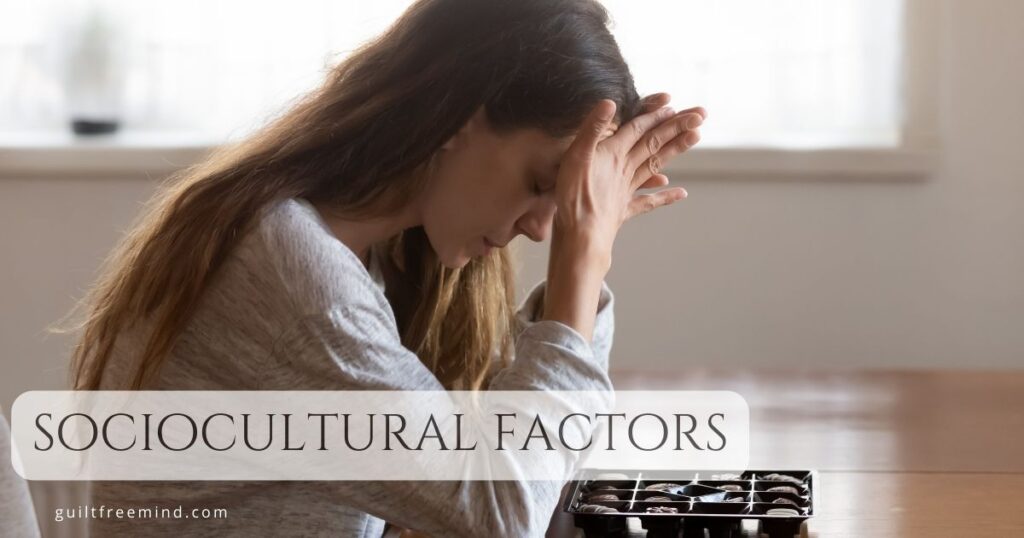
Gender roles and expectations
Societal pressure
As per the traditional gender role, women are supposed to be the caregiver, mother , maintain the family harmony, take care of the kids and yet-be able to manage and excel at her profession. Balancing the expectations of both family and work can be very stressful and lead to anxiety.
On the other hand societal expectations with regards to the appearance, behavior and achievement levels can create a sense of inadequacy or lead to a constant fear of judgement.
Challenges of the workplace
Women may also have to face workplace specific challenges pertaining to their gender like unequal opportunities, workplace discrimination based on gender, the overlyhigh expectation of being able to manage family and professional life without a hitch. All of these can lead to the development of work-related anxiety.
Past trauma
Traumas leave scars that are not visible to anyone. Only the sufferer understands the impact of that life-changing situation. Traumas also affect women differently since they have a higher chance of experiencing domestic abuse and sexual assault. Such past can lead to the persons world view getting distorted. They may constantly start living in a headspace of heightened vigilance, anxiety and fear in different aspects of their lives.
Recovery and coping mechanisms
Sociocultural factors also have a huge impact on the coping mechanism available to women. The availability of supportive networks, provision to resources for mental health and the cultural attitudes that are focused on providing help to women can have a huge impact on the women’s ability to develop coping mechanisms and recover from the past trauma..
Common anxiety symptoms in women
Anxiety is never only restricted to how one feels. It can have a huge impact on a person’s physical, emotional and cognitive functions. Understanding the anxiety symptoms in women is the first step towards early detection, quick intervention and support. Lets have a look at the different ways anxiety manifests in case of women
Emotional symptoms
Constant and excess worry
- Women who experience anxiety often feel a gnawing, persistent, and overwhelming level of worry. Their worry levels are way off what is considered to be within normal limits.
- Their worry may be regarding relationships, family, work, or expectations of society, leading to a high level of apprehension and fear.
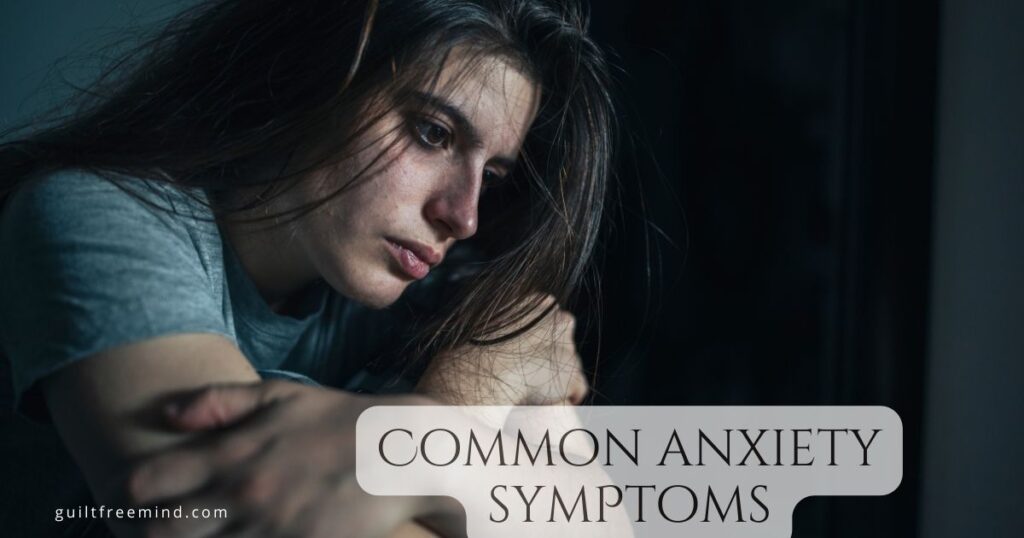
Mood swings and irritability
- Anxiety can also manifest itself as mood swings, irrational irritability or a heightened emotional sensitivity.
- Mood fluctuations can also be the result of hormonal changes, life stressors
or the constant worry and struggle of meeting the expectations of society.
Physical Symptoms
Muscle tension
One of the very common symptoms of anxiety is tensing up of the muscles, This especially happens in shoulder, back and neck regions. Constant tensing of the muscle can lead to headaches, body aches and general heightened discomfort.
Sleep disturbances and fatigue
Most often, anxiety interferes with one’s sleep patterns. It may cause restless sleep or insomnia. One may also experience persistent fatigue due to a combination of high levels of disturbed sleep and mental alertness.
Cognitive Symptoms
Racing thoughts
- Women who experience anxiety may also experience intrusive or negative thoughts. This makes it challenging to focus on their tasks on relax.
- Constant overthinking and a hyperactive brain also contributes to enhanced stress levels.
Difficulty in focusing
- One of the most common anxiety symptoms in women is cognitive impairment. This leads to difficulty in focusing on making desicious.
- The constant and insessant worry may also negatively impact the cognitive process. This can impact relationships , work and evendaily life.
Understanding anxiety symptoms in women in different life stages
Understanding anxiety in different stages of life is crucial for providing targeted support and therapy options for women. Anxiety has a tendency of manifesting in different ways depending on the stage of life the person is in. At every stage, it bringsits own challenges with itself. Lets understand how anxiety unfolds in various stages:
Adolescence and young adulthood
Social and academic pressure
- During adolescence stages, girls face a high level of social and academic pressure which can contribute significantly towards anxiety development.
- At this stage, girls are also intensely concerned about the body image, peer relationships as well as academic performance. This may increase by their anxiety.
Relationship with peers
- During this period, the social dynamics and desire to be accepted among the peer group is high and can be the cause /exacerbate existing anxiety.
- Girls also worry about the judgement of others and if they will be excluded from their peer groups. This has a huge impact on their behavior and self-esteem.
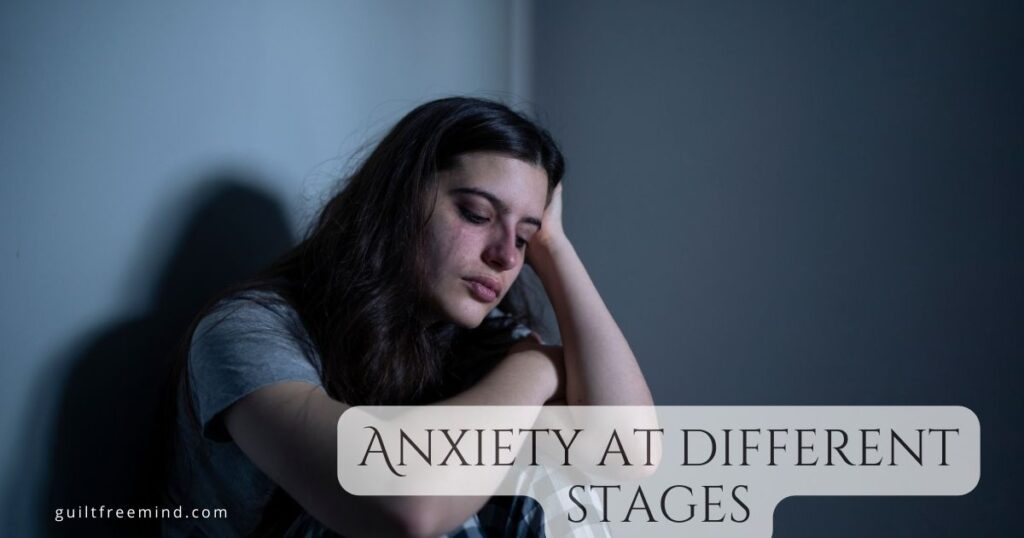
During the motherhood stages
Postpartum anxiety
New mothers are very often hit by the postpartum anxiety, characterized by excessive worry about the health and well-being of the newborn, fear of being inadequate as a parent and suffering from intrusive thoughts.
Sleep deprivation, hormonal changes and the sudden adjustment to new motherhood responsibilities lead to worry and contribute to anxiety development.
Balancing motherhood responsibilities and personal well-being
Motherhood comes with many demands. Juggling those alongside personal and professional responsibilities can contribute to development of high levels of stress and anxiety.
Menopause
- During menopause women undergo severe hormone fluctuations which in turn our cause anxiety.
- The physical symptoms of menopause like hot flashes along with the psychological impact of hormonal changes increases a person’s chances of developing anxiety.
Getting help
The first step in dealing with anxiety is understanding that you have anxiety. The second step is asking for help. If you suppress your problem, it will only grow. You deserve a better and happy life. All you have to do is extend your hand and grab it for yourself. No one else can make your life better. Only you can. So do it. It is crucial to break down the stigma that surrounds mental health. You must understand the importance and benefits of getting help and the different avenues that are available for your support.
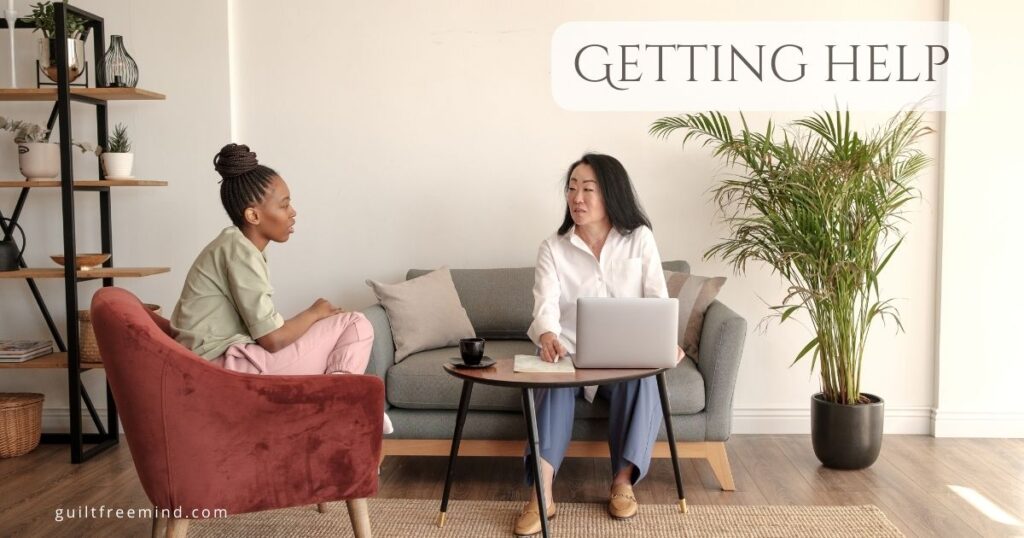
Breaking the stigma of anxiety symptoms in women
The stigma surrounding mental health will only reduce if open conversation about mental health is encouraged. It all starts with talking about the problem.
- Talk with your therapist, family members, friends, communities and your colleagues at your workplace about metal health. If you feel comfortable, talk to them about your problem.
- If you do not feel comfortable discussing your problem with them, then find online communities where you can discuss about anxiety. Discuss it with those who are like-minded and are probably suffering from the same problem as you.
- Individuals should recognize that anxiety is a part of life. At some point, everyone feels anxious. Getting help for your mental health should not be looked down upon. It is a part of one’s overall well being.
- Initiate development of education programs to normalise mental health. These programs can clarify the myths regarding anxiety and promote understanding about other mental health conditions as well.
Treatment Options for anxiety symptoms in women
- Many evidence based therapeutic approaches are available for thetreatment of anxiety like cognitive behavioral therapy, dialectical behavioral therapy etc.
- Groups or individual therapy sessions can provide youinsights into the root cause of your anxiety and offer you a safe place for free discussion.
- If you are suffering from severe anxiety, you may be prescribed medication to help with symptom management.
- Never self medicate. If you know of a medication, before determining the appropriateness of the medication, always consult with a health care professional. They can tell you if the medicine is right for you based on your health and treatment modality.
- You can also employ holistic approaches like relaxation-techniques, yoga, mindfulness to help keep you calm.
- Lifestyle modifications like balanced diet, regular exercise and sufficient sleep have huge role to play in contributing towards your overall well being.
Community support and resources
- Be part of support groups that are focused on connecting with women facing similar difficulties.
- When you share your experiences with others, it can empower you and them alike.
- Check out online platforms that can provide you crucial resources, information and other details so you can use them to work on yourself.
- Use self-help tools like journaling, doodling and virtual communities to work on your own mental health.
- Get help from professionals like psychiatrists, psychologists etc. They can tailor your therapeutic strategy as per your needs.
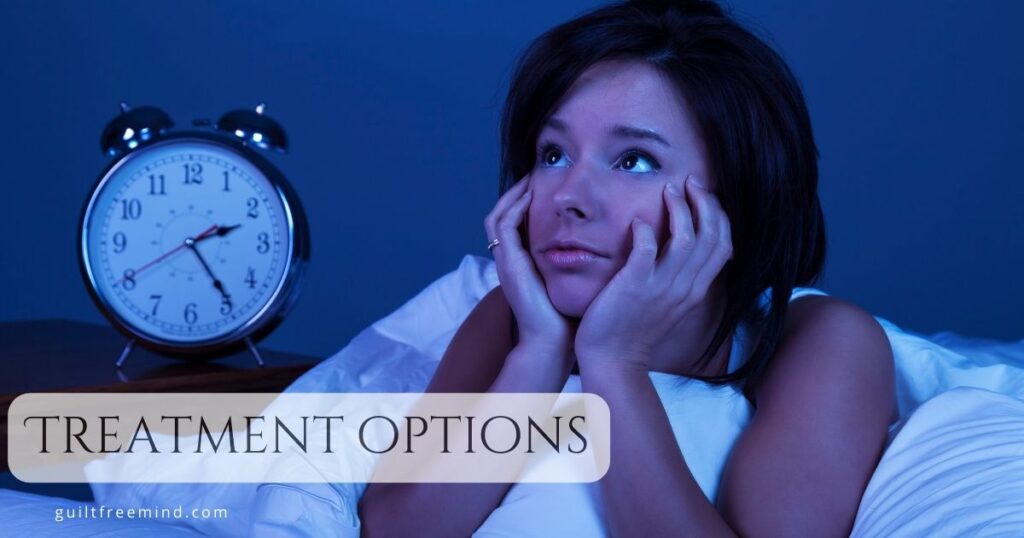
Conclusion
The anxiety symptoms in women are a result of a variety of factors like socioeconomic, cultural, biological and the life stage that they are at. Anxiety in a pretty common and prevalent mental health condition that affects both men and women. However the symptoms in women are different. The manifestation of anxiety in women influences their emotional, cognitive and physical well-being.
The most common anxiety symptoms are mood swings, irritability, and an impending sense of doom to name a few. This constant fear and worry causes muscle tension and difficulty focussing. The intensity of these symptoms may vary depending on the life stage of the person.
You deserve to lead a fulfilling and wonderful life. So get the help you nightfully deserve. In turn you will also be contributing towards reduction of the stigma associated with mental health that is currently plaguing our society.
If you found this blog post insightful, please subscribe to Guilt Free Mind. The subscription option is present in the sidebar. If you like watching videos, subscribe to the YouTube channel of Guilt Free Mind. Do not forget to ring the notification bell so YouTube can notify you when the next video releases from the channel. If you have any queries, put them down in the comment section I will answer them as soon as possible.
See you in my next blog post
Frequently Asked Questions
The most common anxiety symptoms in women are high worry, muscle tension, restlessness, sleep disturbance, constant fatigue and having a very hard time concentrating.
In case of women, anxiety mostly starts as feelings of fear, nervousness, or constant tension and worry. They may also experience physiological symptoms like high heart rate, trembling , panic attacks etc. Women are also more prone towards developing some of the common anxiety disorders like panic disorder and generalized anxiety disorder.
Yes! The hormonal fluctuations that occur throughout the month in the body of a women lead to changes in mood , irritability, and other symptoms.
Most major life events like childbirth, parenting or suddenly taking over a caregiver’s responsibility can lead to high levels of anxiety in women. During such life events, women also face high demands and stressors from their environment.
Managing anxiety in women involves a multifactorial approach. There has to be an amalgamation of several different approaches, employed together, like deep breathing exercises, mindfulness, adequate sleep, health eating, and finally getting support from mental health professionals and family members. All of these factors contribute immensely towards anxiety management.
